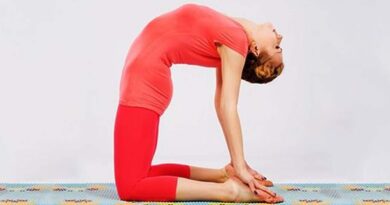Dandasana Yoga: Cultivate Strength and Stability with Staff Pose
Table of Contents
Introduction
Dandasana Yoga, also known as Staff Pose, is a foundational seated posture in yoga that promotes strength, stability, and alignment. Derived from the Sanskrit words “danda” (meaning staff) and “asana” (meaning pose), Dandasana symbolizes the grounding and steady support of a staff.
In this article, we will explore the steps, benefits, variations, and precautions associated with Dandasana Yoga, empowering you to cultivate a strong and balanced foundation for your yoga practice.
How to Perform Dandasana Yoga
To practice Dandasana Yoga, follow these step-by-step instructions:
Step 1: Begin by sitting on the mat with your legs extended in front of you.
Step 2: Place your hands slightly behind your hips, fingers pointing toward your feet.
Step 3: Press your palms into the mat and engage your core muscles to lift your spine tall.
Step 4: Flex your feet, pressing your heels into the ground.
Step 5: Lengthen through the crown of your head and imagine a straight line extending from the base of your spine to the top of your head.
Step 6: Relax your shoulders away from your ears and elongate your neck.
Step 7: Draw your lower belly in and keep your chest lifted, maintaining a gentle engagement in your core.
Step 8: Breathe deeply and hold the pose for several breaths, finding stability and strength in your seated position.
Step 9: To release the pose, gently lower your hands and extend your legs forward.
Benefits of Dandasana Yoga
Regular practice of Dandasana Yoga offers a range of physical, mental, and energetic benefits, including:
Improved Posture
Staff Pose helps to correct and improve overall posture by elongating the spine and opening the chest.
Strengthened Core Muscles
The engagement of the core muscles in Dandasana builds strength and stability in the abdominal region.
Enhanced Focus and Concentration
The alignment and stillness required in Staff Pose promote mental focus, clarity, and concentration.
Increased Flexibility
Dandasana stretches the hamstrings, calf muscles, and lower back, gradually increasing flexibility in these areas over time.
Improved Digestion
Sitting in a tall, upright position in Staff Pose aids in digestion by creating space in the abdominal area and promoting healthy digestive function.
Grounding and Calming
The grounded nature of Dandasana Yoga helps to create a sense of stability, grounding, and calmness in both the mind and body.
Variations of Dandasana Yoga
Explore these variations of Dandasana Yoga to modify the pose according to your level of practice and comfort:
a. Supported Staff Pose: Place a bolster or folded blanket under your sitting bones to provide support and elevation, especially if you have tight hamstrings or lower back discomfort.
b. Half Staff Pose: If fully extending both legs is challenging, you can practice Half Staff Pose by bending one leg at the knee and placing the foot on the inner thigh of the opposite leg.
c. Ardha Dandasana Yoga (Half Staff Pose with Twist): From Staff Pose, twist your torso to one side, placing your hand on the outside of the opposite knee. This variation provides a gentle spinal twist and enhances the benefits of Dandasana.

Precautions and Contraindications
While Dandasana Yoga is generally safe for most practitioners, it’s important to consider the following precautions:
a. If you have any existing or recent lower back or hamstring injuries, approach Dandasana with caution and modify the pose as needed. Seek guidance from a qualified yoga instructor or healthcare professional.
b. Pregnant women should avoid practicing Dandasana Yoga in the later stages of pregnancy, or modify the pose by sitting on a bolster or cushion for added support.
c. Individuals with spinal conditions, such as herniated discs or sciatica, should consult with a healthcare professional before attempting Dandasana or modify the pose accordingly.
Conclusion
Dandasana Yoga, Staff Pose, invites practitioners to cultivate strength, stability, and alignment, establishing a strong foundation for their yoga practice. This foundational seated posture offers a multitude of physical, mental, and energetic benefits, promoting improved posture, strengthened core muscles, enhanced focus, and increased flexibility.
Embrace the strength and stability of a staff as you explore Dandasana in your yoga journey. Approach this pose with patience, attentiveness, and a focus on alignment. Allow the empowering qualities of Staff Pose to support you in finding stability and balance, both on and off the mat.
With regular practice, Dandasana Yoga can become a symbol of your inner strength, resilience, and the unwavering support you provide for yourself in your yoga practice and in life.





